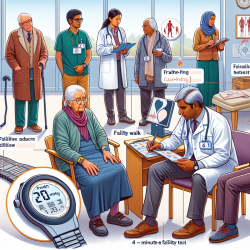Understanding Frailty in Primary Care
Frailty is a multidimensional condition that increases vulnerability in older adults, often leading to significant health crises. With prevalence rates in Canada reaching 25% in those aged 65 and older, early identification and intervention are crucial. The research article "Identification of Frailty in Primary Care: Feasibility and Acceptability of Recommended Case Finding Tools Within a Primary Care Integrated Seniors’ Program" explores practical tools to identify frailty in primary care settings.
Key Findings from the Research
The study examined the feasibility and acceptability of three frailty case finding tools: PRISMA-7, the 4-m walk test, and the electronic frailty index (eFI). These tools were tested within a primary care setting in Alberta, Canada, involving 85 patients and 16 healthcare providers.
- PRISMA-7: A questionnaire with a 97.6% completion rate, requiring no special training or equipment.
- 4-m Walk Test: A physical test with a 93% completion rate, requiring minimal training and equipment.
- Electronic Frailty Index (eFI): A comprehensive tool with a 100% completion rate, requiring more time but found less intrusive by providers.
Implementing Frailty Case Finding Tools
The study highlights the importance of using tools that are feasible and acceptable to healthcare providers. The PRISMA-7 and 4-m walk test were quick to administer, taking less than 5 minutes each. The eFI, although more time-consuming, provided valuable insights without disrupting clinical workflows.
Healthcare providers expressed a preference for tools that required minimal resources and offered added benefits, such as enhanced patient understanding and streamlined access to services. The study suggests that a two-step approach, using a simple tool followed by another, can improve diagnostic accuracy.
Encouraging Further Research and Practice
While the study provides valuable insights, it also highlights the need for further research into the feasibility and acceptability of these tools in diverse clinical settings. Practitioners are encouraged to explore these tools and consider their integration into routine practice to improve patient outcomes.
To read the original research paper, please follow this link: Identification of Frailty in Primary Care: Feasibility and Acceptability of Recommended Case Finding Tools Within a Primary Care Integrated Seniors’ Program.










